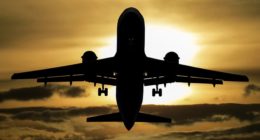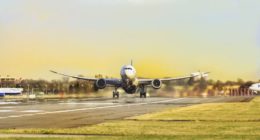We all know that feeling of a sudden drop or being jostled from side to side on an airplane. Then there’s the ominous cabin bell ding followed by: “Ladies and gentlemen, we are running into some turbulence. Please fasten your seat belt.”
It’s a relief to know that most turbulence is harmless because planes are built to withstand it. But air travelers might find it helpful to understand the causes, types, and categories of turbulence. We’ll give you the rundown on information and safety.
What is Turbulence?
Airplane turbulence happens when changes in air pressure, wind speed, or direction affect a plane’s stability and movement.
When a plane flies through air which is moving up and down, it shakes and jolts the cabin, creating turbulence. This is what aviation consultant Richard Gonzales calls “rough air”. At lower altitudes, choppy air is caused by hotter air rising from the ground while cold air simultaneously sinks–a process called convection. At higher altitudes, turbulence is more often caused by a jet stream, a fast-moving air current that circles the earth in patterns called circulation cells.
To more deeply understand turbulence, it’s helpful to understand how a plane flies. The plane’s engine propels the aircraft through air masses. The wings of an airplane split the airflow. This creates a pressure difference above and below the wing. When it’s equal, the plane cruises along smoothly. When the pressure on the top of the wing is less than the pressure on the bottom of the wing, it generates “lift.”
Erratic movement of air can cause disruptions in the lift of an airplane’s wings, leading to the jarring experience of turbulence. “Simply put, turbulence is just a change in wind speed and wind direction over a surface,” explains FOX Weather meteorologist Jason Frazer.
While turbulence can be uncomfortable, airplanes are designed to safely withstand it, and pilots are trained to avoid or navigate through it to minimize the effects. However, passengers who choose not to wear their seat belts are at risk of injury if severe turbulence hits. That’s why the FAA recommends passengers to keep their seat belts buckled all the time. Turbulence will alway be an inherent part of air travel, so fasten your seat belt and enjoy the ride–turbulence and all.
Types of Turbulence
According to the National Weather Service, there are a variety of types of turbulence:
Clear Air Turbulence:
Clear air turbulence occurs when a plane flies through clear skies, but is jostled by the eastern-moving air currents called jet streams. A jet stream coming from behind causes a tailwind that increases the speed of the plane but doesn’t induce a bumpy ride. A jet stream coming at the sides can shake the plane and its passengers.
Thermal Turbulence:
Thermal turbulence, also called convective turbulence, is caused by the sun heating the surface of the earth, causing the air to expand and rise. As this happens, towering cumulus clouds form and can sometimes climb higher than the typical altitude of a plane.
Mechanical Turbulence:
Mechanical turbulence is caused when horizontally-flowing wind is disturbed by irregular terrain or obstructions, like tall buildings. The displaced wind causes turbulence.
Wake Turbulence:
Wake turbulence is caused by a disturbance in the atmosphere behind an aircraft as it passes through the air. Although wake turbulence has the possibility of being dangerous, it normally only lasts for a short duration, and smaller planes are much more affected.
Temperature Inversion Turbulence:
Temperature inversion turbulence occurs when a layer of warm air stacks above a layer of cold air, and the air of both layers starts mixing vertically. A plane flying between these layers will feel turbulence.
Self-Induced Turbulence:
A pilot creates self-induced turbulence, usually during aerobatics or abrupt maneuvers.
Frontal Turbulence:
Frontal turbulence is caused by rising warm air and friction between the two opposing air masses. This turbulence is most dramatic when the warm air is moist and unstable–turning extremely severe if thunderstorms develop.
Wind Shear Turbulence
Wind shear is the shift in wind speed and/or direction over a particular horizontal or vertical distance. It’s a common cause of turbulence. When the wind speed or direction change is pronounced, turbulence can be quite intense.
Categories of Turbulence
The FAA categorizes the severity of turbulence as light, moderate, severe, and extreme. Here’s how they are defined.
Light Turbulence:
Light turbulence is characterized by slight changes in altitude, with minor effects on a plane and its passengers.
Moderate Turbulence:
Moderate turbulence is somewhat more intense than light turbulence. Passengers will feel a strain against their seat belts, and unsecured objects may be dislodged in the cabin. However, the pilot maintains complete control of the aircraft the entire time.
Severe Turbulence:
Severe turbulence involves large, abrupt changes in altitude and/or attitude, the angular difference measured between an airplane’s axis and the line of the Earth’s horizon. A pilot may momentarily lose control of the aircraft during severe turbulence, and some objects may come loose in the cabin. However, the overall damage to the aircraft should be minimal.
Extreme Turbulence:
In extreme turbulence, the airplane is tossed violently about and might be impossible to control. Extreme turbulence can cause structural damage to an aircraft.
Frequently Asked Questions:
How long does turbulence last?
The duration varies depending on the severity and expanse of the weather conditions. Generally, turbulence lasts for a few minutes and then subsides. But it can also last through a significant portion of the flight.
How common are turbulences?
Turbulence is relatively common during flights, particularly over certain regions with mountains or convective weather.
Does climate change create more turbulence?
There is evidence that climate change may cause an increase in turbulence, particularly in the upper atmosphere, but more research is needed to fully understand the impact.
Is turbulence dangerous?
While turbulence can be disconcerting, it is generally not dangerous. Pilots are trained to avoid and navigate through turbulence to minimize its effects. Aircraft are designed and tested to withstand turbulence. As Patrick Smith from Ask The Pilot explains, “Conditions might be annoying and uncomfortable, but the plane is not going to crash. Turbulence is an aggravating nuisance for everybody, including the crew, but it’s also, for lack of a better term, normal.” And unless you’re flying in one of the least safe airlines in the world, you’ll be fine.
That being said, severe turbulence can be hazardous to passengers not wearing their seat belts.
How do pilots respond to turbulence?
Turbulence is a normal part of air travel. Pilots are trained to deal with the different categories of turbulence by altering the flight path or altitude and changing the aircraft’s speed to minimize the choppiness of a ride. Both regular weather updates and technology that detects and predicts turbulence allow pilots to make informed decisions and ensure the safety of passengers and crew. While turbulence can be unsettling, it is important to remember that pilots are professionals who are highly trained to facilitate a safe and comfortable flight for all.
Can turbulence be predicted?
Turbulence can be predicted to some extent. Pilots and air traffic controllers receive regular weather updates and use advanced technology to detect and forecast turbulence ahead of time. This information helps them make informed decisions about flight paths and altitudes that can minimize the impact of turbulence.
There are several tools for predicting turbulence, such as turbulence forecasts provided by meteorologists and various weather models. Aircraft also have sensors that detect turbulence and relay that information to the pilots and air traffic controllers, allowing them to adjust the flight path or altitude if necessary.
However, it is important to note that turbulence can be unpredictable and occur unexpectedly even with the best tools and technology.








